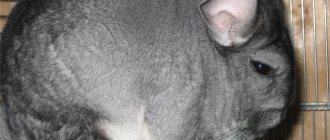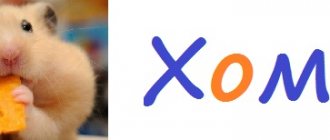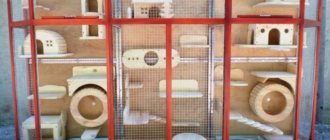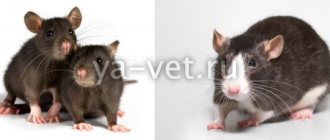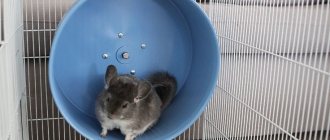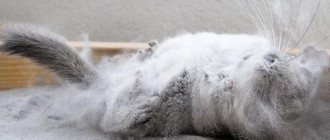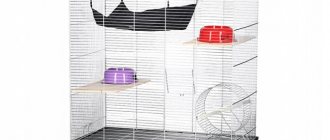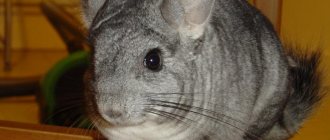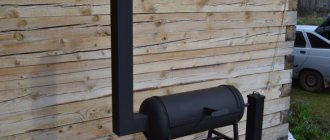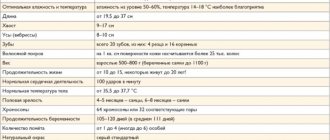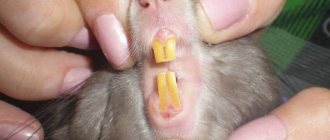When purchasing a furry animal as a pet, you need to know that a chinchilla, like any other rodent, has teeth that grow constantly. The animal is forced to grind them down and therefore constantly gnaws on something hard. And the owner’s task is to ensure that the animal always has solid objects in its cage, such as, for example, mineral stones for chinchillas.
What stones are there for chinchillas?
Not all animals have the same characters and taste preferences. Therefore, it will not be possible to understand in advance which minerals are suitable for a particular rodent.
In the assortment of specialized stores you can find different types of mineral stones for chinchillas:
- loamy;
- salt;
- chalk – mineral;
- chewing;
- minerals containing vitamins and probiotics;
- natural pumice of volcanic origin.
Loamy stone
This is a natural material that many rodents enjoy using to wear down their teeth. In addition, it contains minerals necessary for the animal’s body.
JR FARM stone (best suited to the needs of a chinchilla) consists of natural clay with the addition of wheat, roses and marigold. It contains no artificial ingredients or preservatives. Therefore, it will not cause any harm to the rodent. Composition of loamy stone from this manufacturer:
- protein content – 1.3%;
- fat - 0.5%;
- fiber – 2.3%;
- ash – 89.1%.
How to prepare branches?
Having figured out what branches need and can be given to dwarf hamsters, you can start harvesting them at home. To avoid harm to your pet, the following rules must be followed:
- Collection should be carried out in an area remote from the roadway.
- The product must not have knots that could injure the animal.
- The length of the twigs should not exceed six centimeters.
- The bark should not be peeled off, as its presence promotes soft, uniform grinding of the incisors.
When thinking about getting such a pet as an individual of the hamster order, it is worth studying in detail the information offered about the organization of its leisure time and nutrition. Otherwise, it may happen that the tiny animal will suffer terrible stress due to improper care and suffer greatly.
salt stone
It is better to place minerals containing sodium and other substances necessary for the chinchilla’s body closer to the animal’s drinking bowl. After the teeth grinding procedure, the animal will immediately want to drink.
This Vitakraft Vita Fit Sel plus product has proven to be of good quality, in which the substances necessary for a rodent are organically combined.
Treats
Today, the pet store can offer another option for grinding teeth - grain sticks. They come in different grain compositions with the addition of various minerals and trace elements. This delicacy will definitely please your taste! You can also prepare your hamster’s liver yourself!
cereal sticks
In addition, if you tie the treat in such a way that the hamster has to work hard to get to it, then it will also serve as good entertainment and additional physical activity for your pet.
A hamster should not chew ordinary school chalk; after all, it is non-food and is not intended for such purposes. Food products undergo several degrees of purification, so they are safe for the animal.
Which stone should you choose?
When purchasing abrasive materials for chinchillas, you should give preference to those that:
- have a completely natural composition;
- do not contain substances such as chlorine, lime, iron, aluminum;
- have a natural smell.
The stones should also not contain dyes, otherwise the pet may acquire an unusual color: yellow, pink or green. In addition, dyes have a harmful effect on the animal’s body. The same applies to the various preservatives that some manufacturers include in the composition of the stones.
Often mineral stones for chinchillas are sold in bars that cannot be attached to the animal’s cage. They often fall with a lot of noise, frightening the already impressionable animal. They can also get dirty, wet, and then deteriorate.
It is better to buy minerals that have wire for attaching them to the bars of the cage. Then the rodent will be able to grind down the incisors in a comfortable position.
Useful information about jungarians! :)
3 messages
YOU CAN: 1. Dry food mixture is the main food for the Djungarian hamster.
2. Cereals: * beans; * hercules; * peas; * buckwheat; * oats; * wheat; * beans; * lentils; * barley.
* peanuts; * walnut; * cashew nuts; * sesame (seeds); * chickpeas; * hazelnut
* bamboo; * alfalfa; * oats; * wheat.
* clover; * nettle; * dandelion leaves; * plantain leaves; * parsley; * salad; * dill.
* eggplant; * bell pepper; * broccoli; * peas (young in pods); * zucchini; * Chinese cabbage; * corn (fresh or dried); * carrot; * cucumber; * squash; * tomato (not winter); * radish; * radish; * turnip; * beet; * celery; * green beans; * pumpkin; * cauliflower; * zucchini.
8. Fruits and berries:
* apricot; * banana; * grape; * cherry; * pear; * strawberry; * gooseberry; * peach; * plum; * currant; * cherries; * blueberry; * rose hip; * apples.
* banana chips; * raisin; * dried apricots; * dried pears; * dried apples.
10. Branches of deciduous and fruit trees:
* birch; * beech; * cherry; * pear; * oak; * willow; * maple; * poplar; * Apple tree; * ash.
Do not forget that Djungarian hamsters should eat protein food several times a week.
11. Chicken meat (boiled without salt and spices). 12. Boiled egg:
13. Yogurt without additives and sugar (no more than 1% fat). 14. Kefir (no more than 1% fat). 15. Cottage cheese (no more than 1% fat). 16. Shrimp (boiled and peeled). 17. Earthworms, mealworms, grasshoppers, dried gammarus (only purchased at a pet store).
Article on the topic: How to name a hamster: a list of names for boys and girls, choosing a nickname for the Dzungarian and Syrian breeds
For feeding newborn dwarfs.
18. Meat or vegetable baby food (no additives, sugar, salt or soy). 19. Dairy-free cereals (no salt or soy), as well as regular cereals soaked in water. 20. Boiled rice (recommended for diarrhea).
Agree that the list of what you can feed Djungarian hamsters looks quite impressive. Next, let's talk about what is considered controversial issues. However, the foods listed below can cause serious harm to the health of jungarians. Therefore, we classify them as “not recommended.”
1. Food mixtures for other rodents or birds. 2. Drops for rodents (often contain harmful components). 3. Brazil nut. 4. Acorns. 5. Potatoes. 6. Cheese. 7. Bread (white) and crispbread. From the Happy Djungarik blog.
Hello, dear friends! We have already talked to you about the importance of the correct dimensions of a hamster cage. Another determining element on which the activity, physical fitness and health of the dwarf dog depends is the wheel that is suitable for your pet. The wheel in the Djungarian hamster's cage is a perpetual motion machine and a favorite exercise machine on which your rodent will spend most of its time. The importance of choosing the right wheel for a dungeon is colossal, so I suggest you carefully understand all aspects in order to fully master this issue.
In any pet store you can see dozens of wheels of various models, designs and colors. However, prices for similar products may differ by an order of magnitude. But “expensive” in this case does not always mean “good”. Don’t forget that in addition to the Djungarians, there are, for example, Syrian hamsters, which are much larger in size. We are interested in a wheel that will fully comply with the standards of care for your pet. Wheel diameter for dzhungarika
Article on the topic: How to tame a red-eared and land turtle
The first parameter you need to pay attention to. It depends on what type of hamster the wheel was made for. As a rule, products with a diameter of 18-20 cm are designed for Syrian hamsters, 14-16 cm for Djungarian hamsters and small Syrians, and anything smaller is only for baby Djungarian hamsters. Please be careful when purchasing. Often, cages are equipped with running wheels with a diameter of 11-12 cm, which is completely unacceptable for a mature dwarf. Yandex.Direct Interior Design! Get started for free Promotion until March 8: From 100 m2, a preliminary design project is free. Try it now! Attention, Promotion · Real portfolio. Click · Reviews of the work of Studio DiaAddress and phone number dia.by Kitchens photo. Gallery of our kitchens! Kitchen photos. Take a look and if you like it, order it. PRIMEBELI company. Ready-made kitchens MDF · Ready-made kitchens laminated chipboard · Contact usprimebeli.by
How can you tell if the wheel you purchased is not suitable for your pet? If while running your hamster constantly stumbles or bends too much, then the wheel for your hamster is too small. Hurry up to change the “simulator” before your pet causes itself an unwanted injury. Damage to the spine, dislocations and broken legs are the tragic consequences of the inattention of some owners to their pets. Wheel surface for dzhungarik
Here we are talking about the “treadmill” of the wheel, along which your dwarf crawls with its paws. A huge number of wheels on sale have a lattice surface. You should not buy such products - they are unsafe. While running, the dwarf's paws can fall between metal or plastic rods, which often leads to injuries to the limbs. What are the alternatives? The best option is to buy a wheel with a solid plastic surface or with a fine metal mesh, into which your pet’s paws cannot fall. Such “simulators” guarantee the safety of your jungarik while jogging. Summary: what an ideal wheel for a dzhungarik looks like
Article on the topic: Rosette guinea pig (rosette, Abyssinian) - description of the breed with photographs
Wheel diameter: 14-16 cm. Wheel surface: solid plastic or fine metal mesh
See you again, dear readers! From the Happy Djungarik blog. Advertising inclusive.
Hello, dear friends! Remember when we talked to you about the teeth of Djungarian hamsters? We then discussed common problems and looked at how to care for the teeth of a dzhungarik. However, many questions remain. Why does my pet ignore the mineral stone? How to deal with a hamster chewing its cage? There is a solution, and today we will look at an excellent remedy for caring for the teeth of jungarians - dandelion roots and Little One currant branches.
Is your hamster constantly chewing on his cage, making a terrible grinding sound? "Why?" - you ask, because he has a mineral stone for rodents in his cage. Unfortunately, this problem is not at all uncommon: many hamsters completely ignore special stones for grinding down their incisors. But under no circumstances should you let the situation take its course. If your dwarf is chewing on its cage, you need to deal with it. Firstly, there is a risk that the pet will simply break its teeth, choke, or be poisoned by paint from the bars of the cage. And secondly, banal damage to the cage or any accessories in the pet’s home, because hamsters often chew plastic houses, running wheels and other items not intended for this purpose. Dandelion Root Little One
Many of our readers ask me in surprise: “What is this anyway?” Everyone knows what a dandelion looks like, but what are its roots? If you are wondering the same question, take a look at the image:
Dandelion Roots Little One Dandelion root is not only an excellent remedy for your hamster's teeth, but also a healthy part of his diet. By grinding down its incisors, the jungar will receive calcium and other minerals. In addition, dandelion roots contain inulin, which strengthens and heals your hamster’s liver. Our pet takes great pleasure in gnawing on Little One dandelion roots!
